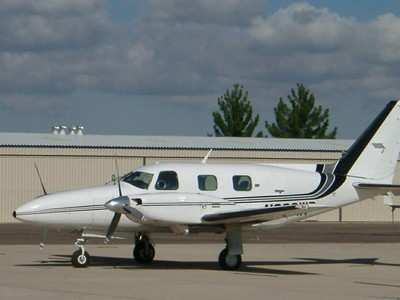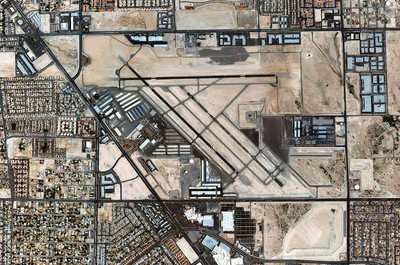 As previously reported, a Piper PA-31 Navajo (file photo, below)
twin impacted power lines before it crashed into a parked car in a
driveway located about 1/2 mile from the runway at VGT, on
Thursday, August 28th. The aircraft came to rest
against a block wall in the home's backyard. FAA spokesman Ian
Gregor said the plane's pilot, the sole person onboard, reported a
"rough-running engine" shortly after takeoff. The aircraft was
returning to the airport when it crashed at approximately 2:35 pm
local time, killing the pilot. Witnesses said the plane was
trailing smoke and even flames as it approached the airport. The
aircraft exploded on impact, triggering a fire that burned one home
nearly to the ground and scorched a second.
As previously reported, a Piper PA-31 Navajo (file photo, below)
twin impacted power lines before it crashed into a parked car in a
driveway located about 1/2 mile from the runway at VGT, on
Thursday, August 28th. The aircraft came to rest
against a block wall in the home's backyard. FAA spokesman Ian
Gregor said the plane's pilot, the sole person onboard, reported a
"rough-running engine" shortly after takeoff. The aircraft was
returning to the airport when it crashed at approximately 2:35 pm
local time, killing the pilot. Witnesses said the plane was
trailing smoke and even flames as it approached the airport. The
aircraft exploded on impact, triggering a fire that burned one home
nearly to the ground and scorched a second.
The NTSB's prelim is reproduced below:
NTSB Identification: LAX08FA286
14 CFR Part 91: General Aviation
Accident occurred Thursday, August 28, 2008 in Las Vegas, NV
Aircraft: Piper PA-31-350, registration: N212HB
Injuries: 1 Fatal.
This is preliminary information, subject to change, and may
contain errors. Any errors in this report will be corrected when
the final report has been completed.
On August 28, 2008, at 1434 Pacific daylight time, a Piper
PA-31-350, N212HB, experienced a partial loss of engine power
during climb a few minutes after departing from the North Las Vegas
Airport (VGT), Las Vegas, Nevada. Shortly thereafter, as the
airplane was returning to the airport, the airplane collided with
several objects and eventually a residence. The accident flight was
performed under the provisions of 14 Code of Federal Regulations
Part 91, and visual meteorological conditions prevailed. The
airplane was destroyed by impact with objects and the post-crash
fire. The airline transport certificated pilot, who was the sole
occupant in the airplane, was killed. Of the five persons who were
located at the house, one received minor injuries, and four were
not injured. The airplane was operated by Aeronet Supply, an
airplane brokerage company based in Gardena, California. The flight
originated from VGT's runway 07 about 1422.

According to Aeronet's owner, the recently hired contract pilot
was intending to fly the airplane to Palo Alto, California, where
the connection of previously installed ferry tanks and avionics
would be completed. Thereafter, upon obtaining Federal Aviation
Administration (FAA) approval, the modified airplane was to be
flown to Korea at the request of its prospective new owner.
The National Transportation Safety Board investigator's review
of FAA recorded radar data indicated that after the pilot took off
from VGT (elevation 2,205 feet mean sea level), the pilot turned
westbound while climbing. About 1427, the airplane was passing
abeam and north of VGT, and it was climbing through 3,400 feet, as
indicated by its altitude encoding Mode C transponder. About 1429,
the airplane was about 5 miles west of VGT and had climbed to 3,900
feet, which was the maximum altitude gained during the accident
flight. The airplane lost altitude during its course reversal left
turn, and by 1431, the eastbound airplane was descending through
3,200 feet. About 1432, the pilot advised a radar controller at the
FAA Las Vegas Approach Control Facility that he was "declaring an
emergency" and desired to "immediately" return to runway 07 at VGT.
Without delay, the controller cleared the pilot as requested.

The airplane continued tracking toward runway 07, and its last
recorded altitude, about 1433:49, indicated the airplane was at
2,400 feet.
The airplane impacted a tree, power lines, an unoccupied
automobile, and the side of a house while coming to rest about 1.2
miles west of the runway's landing threshold. The airplane was
fragmented during the impact sequence, and thereafter it was
destroyed by fire.
Two ground-based witnesses, located about 6 miles west of VGT,
called 911 when they observed the airplane flying near their
location. The witnesses reported observing fire and white smoke in
the vicinity of the airplane's right engine.
The airplane has been recovered from the accident site. An
examination of its engine assemblies, propellers, and fuel system
is pending.
 Airborne 04.16.24: RV Update, Affordable Flying Expo, Diamond Lil
Airborne 04.16.24: RV Update, Affordable Flying Expo, Diamond Lil ANN's Daily Aero-Term (04.20.24): Light Gun
ANN's Daily Aero-Term (04.20.24): Light Gun Aero-News: Quote of the Day (04.20.24)
Aero-News: Quote of the Day (04.20.24) Aero-News: Quote of the Day (04.21.24)
Aero-News: Quote of the Day (04.21.24) ANN's Daily Aero-Term (04.21.24): Aircraft Conflict
ANN's Daily Aero-Term (04.21.24): Aircraft Conflict





